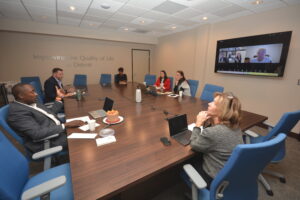In late 2023, the Cranbrook Educational Community announced that after a comprehensive search, Michael Stone-Richards was named one of two Deans to lead the Cranbrook Academy of Art.
As the Dean of Programs and Partnerships, Stone-Richards will work in a curatorial role to increase representation within the graduate curriculum, and to expand audiences across the Academy. He will also conduct direct outreach to develop and support active partnerships in the City of Detroit and work closely with the academy director to steward major gift initiatives such as the Gilbert Family Foundation Gift. Stone-Richards will also act as the head of Critical Studies where he will be developing new directions in the Humanities.
DII sat down with Stone-Richards to hear his thoughts on this robust role, and where he thinks he can make an impact.
DII: Tell us about your background as it relates to this position
Stone-Richards: I have spent most of my professional life teaching in art and design schools. I came to the U.S. in 1994 to teach Art History and Comparative Literature at Northwestern University. After a period teaching in Boston and living in New York, I moved to Detroit in 2006 to teach Critical Practice and Visual Studies at the College for Creative Studies.
From the moment I arrived at CCS, I started prepping students for elite art schools such as Alfred University, Yale School of Art, CalArts, etc. I developed a new style of teaching responsive to where students were coming from and shaping the curriculum around what students were interested in, and this attracted a lot of students. I find abstract ideas of standards incomprehensible.
The position of Dean of the Cranbrook Academy of Art became available and I applied. The role was absurdly ambitious and involved many components. As I and others – including Lynne Tomaszewski – went through the interview process, the position was re-defined into two distinct roles. Lynn is now Dean of Academic Affairs, and I am Dean of Programs and Partnerships and the Head of Critical Studies. It was as if the job was created for me.

MICHAEL STUDYING UP ON CRANBROOK
DII: Is it unusual for the Dean role to be structured in this way?
SR: It’s not unusual. This is the first time I’ve heard of it happening locally in the Detroit area but splitting the job of dean happens when multiple individuals have very specific talents that can shift the needle. It was an act of imagination on the part of the Director to see this possibility and not just tick the box of a job description.
DII: What about moving to Detroit inspired you?
SR: I had a couple of offers at the time, one was from CCS, and the other Colorado College. To this day I’m a bit surprised I chose Detroit – but it’s been wonderful. At that time (it was 2005 – 2006) I started to think about what was going on in Detroit: MOCAD was about to open, and the president of CCS, Rick Rogers, put me in touch with Marsha Miro, a co-founder and the first acting head of MOCAD. It soon struck me that the art scene in Detroit was richer and more complex than one could know from the outside. There was a moment when it all came together through many emerging friendships with artists and writers, and it made sense to me, what role I could fulfill. In the summer 2007, New Music Detroit led by Ian Ding performed Steve Reich’s Music for 18 Musicians. This extraordinary performance in MOCAD was my image of the possibilities of art in Detroit.
When I arrived to teach at CCS, I had been working as a professional art historian and scholar of comparative literature. Within two years, however, I discovered I was not doing that anymore and that there was something sad about teaching in ways that simply did not connect with students. In 2011 one of my favorite students designed my first personal website for me and when I saw it, it was as though I was looking at myself for the first time in a long time. But, at first, it almost could not recognize myself! Everything I was doing – talking to and working with writers, poets, and artists – had nothing to do with what I used to teach at Northwestern. At first, I panicked but almost as quickly I realized that I was doing more interesting and compelling work in Detroit than I had been doing at Northwestern as I began to get at the question – the challenging question –
Why Art? In this place? What difference does it make and why does it affect some and not others? I am not so much interested in playing at being an artist, rather I am interested in what it is that Art makes possible, what kind of talking it is that art seems to induce, what language of intimacy, etc.
I started to realize there is another way of looking at my development, my practice. I started paying closer attention to how artists think, and their critical practice. MOCAD is where, for example, I first heard of Theaster Gates whom I think of as something like the Beuys of contemporary American art and with whose practice I have been in dialogue ever since. Scott Hocking is another artist of great historical sensibility that surpasses most academics, but it is simply another way of thinking. It was a new kind of work – more creative – and I had developed a dialogue with wonderful and talented students. I think this prepared me for assisting in the development of a new generation of artists in the work that I will do at Cranbrook.
DII: Your multiple roles sound like your calendar will be full. Tell us how you will approach them.
SR: I think it’s about synthesizing and connecting the pieces.
As Dean of Programs, I will be responsible for curating the academy-wide lectures. I alone do not choose, of course, but I will pull things together, reach out, make suggestions etc. The Gilbert Foundation recently gifted $30 million to Cranbrook and part of that is meant to encourage diversity in speakers as well as visiting senior artists. One of the ways we will use the gift is to bring in speakers, curators, and writers of the highest caliber who can impact the discourse on art nationally and internationally.

CRANBROOK ACADEMY OF ART
In terms of Partnerships, when I first looked at the job description, I interpreted it as curating the artistic relationship between Detroit and Cranbrook.
Then I realized that in this case, partnerships are also about foundations. It’s about collaborating with businesses and other entities to create job opportunities for students. A significant aspect of the Gilbert Gift has been set aside to facilitate the development of entrepreneurial relationships so that when students graduate there are more opportunities in Metro Detroit for them. The idea is over time to build a culture that will encourage artists and designers to remain in Detroit.
In terms of Critical Studies – this is the type of work I’ve been doing for 17 years at CCS. I am developing an independent program that will lead to a Master of Arts degree. Cranbrook has a world-class teaching museum and library and a brilliant setup for artists. The resources we have are unparalleled for any art school in the region. We want to bring together these resources to attract students nationally and internationally. To be a contemporary cutting-edge artist is to make art marked by history and criticality, so the development of critical studies will be key to attracting talented students. The great Surrealist, André Breton, famously said,
“We now know that art must lead somewhere,” that is, have something to say about the world of values.
So, all of my work interlinks. If we can attract major speakers, raise the profile of Cranbrook, and bring attention to more students, these are the people we want to attract and nurture.
DII: Is Cranbrook looking to place a stake in the ground in the city of Detroit?
SR: The answer is yes – but. Everybody agrees that Cranbrook needs to be in Detroit physically. The conversation was slowed down by the recent departure of the director. So, it’s a question now of timing and strategic decisions.
DII: What impact are you looking to make at Cranbrook?
SR: That’s an important question. First, there is an extraordinary legacy on which to build – from the Eames and McCoys to McArthur Binion, Nick Cave, Toshiko Takaezu, and so much more. I want to be able to develop a program in Critical Studies that attracts students and teachers that will have an impact on the city, and also through the city project – a national and international discourse. Cranbrook is the only place in metro Detroit that will be able to attract that caliber of experimental student.

CRANBROOK ACADEMY OF ART
DII: Now what is your take on Detroit and the art scene here?
SR: With Addie Langford, I co-founded the journal Detroit Research (since 2015) with support from the Knight Foundation and Rick Rogers, then President of CCS. Volume 3 On Sound recently came out. We have published over 1200 pages. It’s not only about Detroit but about placing the art practices of Detroit within a national and international conversation.
These artists and brilliant students feel that Detroit allows them to experiment in a way that cities like Chicago and New York don’t readily allow. Failure is not an option there. Detroit allows for the creativity of risk and failure and so space for the development of new vocabularies. For instance, amidst much talk of figurative art, I would say that Bakpak Burden (currently on show in Cranbrook Art Museum’s exhibition of Skilled Labor: Black Realism in Detroit) is in the process of creating a new idea of figuration, a new set of terms for the body as archeology. The work is unlike anything out there, crying out for a new vocabulary of response. This is no mean accomplishment. I could say something similar to the performance artist and filmmaker Bree Gant (currently studying for an MFA at Northwestern University when she is not in Detroit). That ability to experiment has attracted a lot of people and helped many creative Detroiters.
In my 17 years at CCS, I witnessed an extraordinary growth of creativity, people coming in, mixing, architectural changes, a lot of grassroots and established institutional activity, and more and more opportunities for artists.
Detroit has a complex economy that allows artists of different levels to do their thing. I’ve witnessed that. There is a rich creative scene that is still evolving in really interesting and compelling directions.
As always, be sure to subscribe to our newsletter for regular updates on all things Detroit.




















